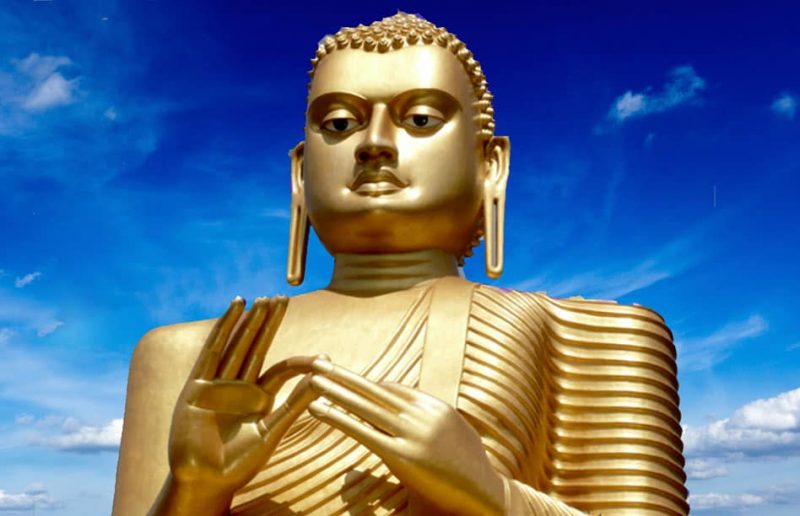Buddha Statues of Sri Lanka
Buddha statues of Sri Lanka
Encountering a Buddha statue is on the card for any traveller, who visits the island of Sri Lanka. Sri Lanka is a country, where Buddhism reigns; Buddhism was the first religion to appear on the island in 3rd century BCE. Today the majority of the islander’s believes in Buddhism, therefore visiting a Buddhist temple and learns about Buddhism is and must in order to learn the life of Sri Lankan people.
According to the historical evidence, the proportions and features of the Buddha image were communicated by the Buddha himself. When a devotee first tried to draw the figure of the Buddha he found he could not render the correct proportions. The Buddha solved the problem by ordering the devotee to trace the outline of his shadow as it was projected on the ground. In another story, a king sent painters to the Buddha to obtain his portrait. They met with little success, so the Buddha himself took the canvas and miraculously projected his features upon it. Through these separate intervention, both proportions and features were ‘captured,’ and were thus able to be handed down in canonical Buddha images.
Although the style of the hair and the robes in Buddha images changed through the centuries, there was no variation in the measurements of the different forms, which were prescribed in the Sinhala Sariputra, or instructions in verse for image-makers.
The basic unit of measurement is the length of the face – especially the distance from the top of the forehead to the tip of the chin. Thus the whole length of the figure should be the equivalent of nine such measurements, the trunk three, and the thighs too. The face itself is divided longitudinally into three equal units. Even such tiny details as the eyelids, the nostrils and the individual hairs on the head had strict guidelines.
The Buddha statues generally assume one of three main postures, in traditional Sinhalese representations, the seated, the standing and the recumbent. Furthermore, the seated and standing images have a characteristic symbol hand gesture or mudras. Which when interpreted by the devotees revealed the meaning of the sculpture.
The seated posture was no doubt inspired by the vision of the Buddha seated under the Bo-tree having attained enlightenment. Indeed, the earliest mention of Buddha images in literature refers to a seated one made during the reign of King Devanampiyatissa, which may have been placed under or near the Bo-tree at Anuradhapura.
The earliest existing example of an image in the seated posture, which was discovered at the Abhayagiri Bo-tree shrine, is now on display in the Anuradhapura museum. Enormous figure of this type can be seen at the Gal Vihara Polonnaruwa and at Tantirimale, Yapahuwa and Seruwila.
In the seated posture, the Buddha is usually lost in contemplation with the right palm placed over the left on the lapin Samadhi Vitarka. However, sometimes such an image shows the Buddha in the discourse, in which case the left hand is raised with the index finger touching the thumb in Vitarka mudra.
The standing posture evolved as a result of the rise in importance of Buddha images from a mere appurtenance to the Bo-tree to an object of veneration in itself. The earliest example of the standing posture can be found in the courtyard of the Ruwanweliseya at Anuradhapura. The standing image, which often appears on a plinth in the form of the lotus flower, is generally straight with the weight on both feet, Sometimes; however, the image is relaxed in a detachment with the weight on one foot, as at the Gal Vihara, Polonnaruwa.
The most common mudras to be found among the standing images are asisa (blessing), with the left palm held up at a right angle to the spectator, Abhaya (fearlessness), with the palm of the right hand held up and facing towards the spectators, and Vitarka (teaching), with the thumb and forefinger of the right hand, joined.
The recumbent posture is the largest form of the Buddha image and has two aspects depending on the position of the toes. If they are together, then the image represents the Buddha reclining. However, if they are slightly apart, the image represents the Buddha in the process of attaining the state of Parinibbana. This state is connected with the well-known but much misunderstood Buddha term Nibbana.
In its original sense, Nibbana means ‘to cool by blowing.’ The cooling referred to is a state of being cooled from the ‘fewer’ of greed, hatred and delusion. Nibbana thus refers to a new level of being – a level into which the Buddha and other early Buddhists who gained enlightenment were considered to have entered, though they still continued to live out what the physical components of that mortal life had reached dissolution, the moment of death, Nibbana was then complete (pari) and this was known as Parinibbana.
Buddha images have been made using various media from the early stages of the art of sculpture in Sri Lanka. The initial images were mostly made from limestone, which was readily available locally. However this stone in soft and therefore susceptible to erosion and the effect of weathering. So most of these early statues are now in a deteriorated state. Sometimes non-indigenous materials were used. For instance, Fa-Hien, the Chinese Buddhist monk and pilgrim of the 5th century, reported seeing an image of jade at the Abhayagiri Monastery in Anuradhapura of considerable size.

